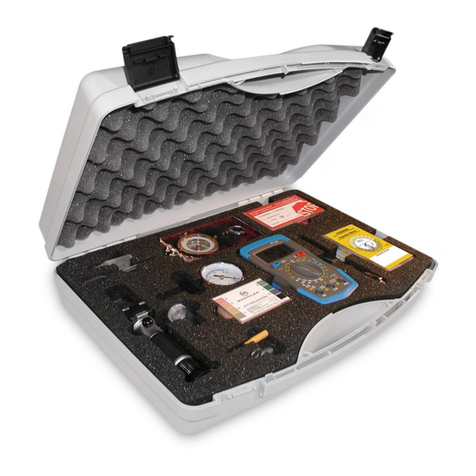
4
Eiskristalle, und es entsteht dann eine immer zähüssigere Masse,
die dann bei einer entsprechend tieferen Temperatur (=Stockpunkt,
Pour Point) vollkommen gefroren ist.
Der bei den meisten Refraktometern verwendete Kälteschutzpunkt
(Frost Point) liegt in dem Bereich, wo die Frostschutzüssigkeit
bereits eine zähüssige Masse (plumpbarer Eisbrei) und somit für
Anwendungen im Solar- oder Wärmepumpenbereich nicht mehr
geeignet ist.
Praktische Anwendung:
1-2 Tropfen der Prüfüssigkeit auf die Prismen-oberäche aufbrin-
gen. (A) Dann den Klappdeckel schließen und auf die Oberäche
leicht andrücken. Das spitze Ende des Refraktometers gegen das
Licht halten und das Okular (C) drehen, bis die Grenzlinie scharf
sichtbar ist. Von dieser Grenzlinie entnehmen Sie die Temperatur
des Eisockenpunktes für das entsprechende Glykol –Wasser-
gemisch respektive den nD20 Brechungsindex von beliebigen
Flüssigkeiten.Sie können mit dem nD20 Brechungsindex von Flüs-
sigkeiten verschiedene Kennwerte der Flüssigkeiten bestimmen,
wenn Sie entsprechende tabellarische Kennwerte besitzen. Bitte
beachten Sie den nD20 - Bereich des Refraktometers!
Wartung:
Damit Ihr Gerät lange genau und reibungslos funktioniert, ist nach
jeder Messung das Gerät mit dem in Ihrer Prüfbox bendlichen
Putztuch zu reinigen. Ist die Prismenoberäche (A) verunreinigt,
da diese schlecht abgetrocknet wurde, so reinigen Sie diese mit
einem Spirituslappen. Das Gerät nicht unter ießendem Wasser
reinigen, da dieses zwar spritzwassergeschützt, jedoch nicht was-
serdicht ist.
Die Kalibrierung des Gerätes erfolgt durch das Öffnen des Klapp-
deckels, 1-2 Tropfen destilliertes Wasser auf die Prismenoberä-
che (A) aufbringen und den Klappdeckel schließen. Das spitze
Ende gegen das Licht halten. Stellen (B) Sie nun die Grenzlinie mit
beiliegendem Schraubenzieher auf Wasserlinie (Waterline). Nun
ist Ihr Gerät kalibriert.
The viscous liquid gets completely frozen at a correspon-
ding low temperature (Pour Point). The most used frost
point for refractometer is located in an area, where the
frost protection liquid is already in a viscous bulk (clumpier
sludge) and not able anymore for using for solar – or heat
pumps areas.
Practical application:
Apply 1-2 drops of the test liquid on the prism surface (A),
then close the lid and slightly press onto it. The pointed end
of the refractometer has to be hold into the light, then turn
the eyepiece until the boundary line is sharply visible. From
these boundary lines you infer the cloud - point for approp-
riate glycolwater mixture,
respectively the nD20 refraction index from arbitrary liquids.
You can determine different liquids with the nD20 refraction
index, when you own the correct tabularization charac-
teristic values. Please consider the nD20 – area for the
refractometer!
Maintenance:
So that your equipment functions exactly and smoothly for
a long time, the equipment with the cleaning cloth in your
test box is to be cleaned after each measurement. If the
prism surface is contaminated, since this was badly dried,
then you clean these with a white spirit rag. The equipment
under owing water do not clean, since this is splash-proof,
however not waterproof.
The measuring of the equipment effected via opening the
hinged cover, 1-2 drops distilled water on the prism surface
apply and the hinged cover close. The pointed end holds
against the light. Set now (B) the boundary line with a little
screwdriver to waterline (0-Linie). Now your equipment is
again calibrated.
kleiner Schraubenzieher little screwdriver
Entlüftungsschlüssel Exhaust key
pH-Messstreifen (84 Stück) pH-measuring tapes (84 peaces)
5
6
7
5
6
7
Entnehmen Sie aus der Solarleitung über den
Entleerungshahn mit dem beiliegenden Gläschen
Wärmeträgermedium. Nehmen Sie aus Ihrer pH-Box
einen Teststreifen und tauchen Sie diesen kurz in
das Medium im Glas. Durch Vergleich des Teststrei-
fens mit der Skala auf der Schachtel lesen Sie den
aktuellen pH-Wert ab. Dieser Messwert soll einen
Wert von 7,0 nicht unterschreiten. Hinweis: Sollte das
Medium dunkel gefärbt oder trüb sein, so wird drin-
gend empfohlen, die Anlage umgehend zu entleeren,
die Anlage mit Wasser gründlich zu spülen und mit
neuem Wärmeträgermedium zu füllen.
Infer from the solar line over the emptying cock
with the enclosed glass heat distribution medium
medium. Take from your pH box a test stripe and dip
you to these briey into the medium in the glass. By
comparison of the color pattern with the scale on the
box discoloured read off you the current pH value.
This measured value is not to fall below a value of
7,0. Note: If the medium should be darkly colored or
gloomy, then is urgently recommended to empty the
plant immediately the plant with water thoroughly to
rinse and with new heat distribution medium ll.
Deutsch English





























